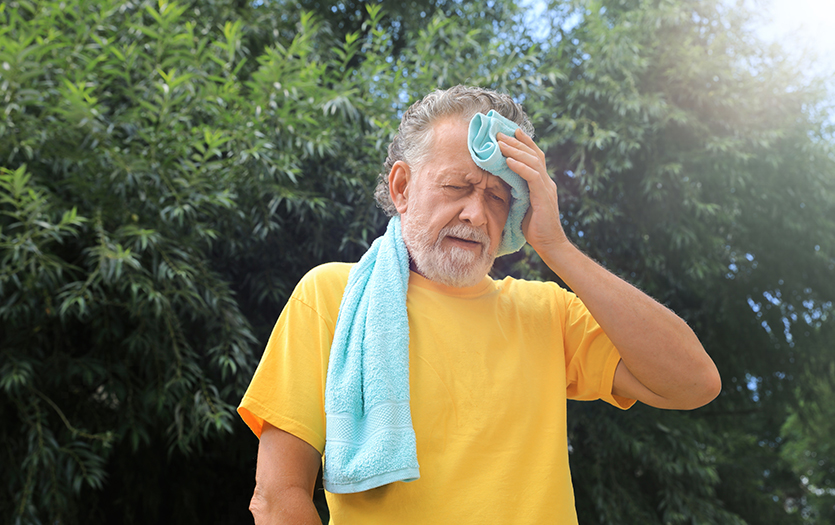During the hot summer months, understanding the difference between heat and dehydration can make all the difference. The conditions of heat exhaustion and dehydration are often intertwined. Each of these conditions present distinct signs and require specific care. Over 600 people in the US die from heat strokes every year.`This statistic itself highlights the importance of recognizing and responding to heat related illnesses.
It is important to note that dehydration can quickly escalate to a much severe condition. If not addressed on time, it can cause kidney failure. In this blog we will be exploring the key differences between heat exhaustion and dehydration. We will also be outlining the symptoms and insights to manage and prevent such conditions.
Master ACLS Now
Get ACLS certified with confidence
Can heat exhaustion cause diarrhea?
Heat exhaustion is a serious condition that causes the body to overheat. This happens due to prolonged exposure to high temperatures. When the consequences and symptoms of heat exhaustion are understood, one can prevent potentially fatal conditions. So to answer the question if heat exhaustion causes diarrhea, yes it does. Let’s explore this in detail.
- Gastrointestinal Disturbances: High body temperatures can affect the digestive system, leading to symptoms such as diarrhea, nausea, and vomiting.
- Electrolyte Imbalance: Excessive sweating and fluid loss can lead to an imbalance of electrolytes, which can disrupt normal digestive functions and result in diarrhea.
- Stress on the Body: The overall stress of heat exhaustion on the body can trigger gastrointestinal upset, including diarrhea, as the body tries to cope with overheating.
Recognizing and addressing these symptoms promptly is essential to prevent heat exhaustion from progressing to heat stroke, a more severe and potentially life-threatening condition. If you or someone else is experiencing signs of heat exhaustion, including diarrhea, it’s crucial to cool down, hydrate, and seek medical attention if necessary.
What is a heat stroke and how can I identify one?
Heat stroke is a severe and potentially life-threatening condition. It occurs when the body’s temperature regulation system fails due to prolonged exposure to the sun.
Heat stroke occurs when the body’s core temperature rises to 104°F (40°C) or higher. Immediate medical attention is required. Here’s how to identify heat stroke:
- High Body Temperature: A core body temperature of 104°F (40°C) or higher is a key indicator of heat stroke.
- Altered Mental State or Behavior: Confusion, agitation, slurred speech, irritability, delirium, seizures, and even coma can occur.
- Hot, Dry Skin or Profuse Sweating: Skin may feel hot and dry to the touch, or there may be heavy sweating.
- Nausea and Vomiting: The affected individual may feel nauseated or vomit.
- Flushed Skin: Skin may appear red as body temperature increases.
- Rapid Breathing and Heart Rate: Breathing may become rapid and shallow, and the heart rate can increase significantly.
- Headache: A throbbing headache is a common symptom.
- Lack of Sweating: In heat stroke brought on by hot weather, the skin usually feels hot and dry to the touch. In heat stroke caused by strenuous exercise, the skin may feel moist.
Read More: How long is my ACLS/PALS certification good for?
How to avoid a heat stroke?
Follow these steps to avoid a heat stroke and take the right precautions before dealing with the summer heat. Below mentioned are a few tips that will help you during the season of scorching heat.
- Stay Hydrated: Drink plenty of water throughout the day, even if you don’t feel thirsty. Avoid alcohol and caffeine, as they can contribute to dehydration.
- Wear Appropriate Clothing: Choose lightweight, light-colored, and loose-fitting clothing. A wide-brimmed hat can also help keep you cool.
- Use Sunscreen: Apply a broad-spectrum sunscreen with at least SPF 30 to protect your skin from sunburn, which can affect your body’s ability to cool down.
- Seek Shade or Air Conditioning: Spend time in air-conditioned buildings or shaded areas during peak heat hours, typically between 10 a.m. and 4 p.m.
- Limit Outdoor Activities: If possible, schedule strenuous activities for the cooler parts of the day, such as early morning or late evening.
- Take Breaks: If you must be outside, take frequent breaks in a cool environment to allow your body to recover.
- Cool Down: Use fans, cool showers, or baths to help lower your body temperature.
- Acclimate Gradually: If you’re not used to high temperatures, gradually increase the time you spend outside to help your body adjust.
- Monitor Medications: Some medications can affect your body’s ability to stay hydrated and respond to heat. Check with your healthcare provider if you’re on any medications that might increase your risk of heat stroke.
- Be Aware of Heat Advisories: Pay attention to weather forecasts and heat advisories, and plan your activities accordingly.
Read More: Elements of Effective Team Dynamics in ACLS
Conclusion
Understanding the correlation between heat and dehydration is essential for managing and preventing these conditions. Both heat exhaustion and dehydration can have terrible impacts on one’s health.
By staying hydrated, wearing proper clothing and taking the proper precautions one can battle the risks of heat exhaustion.







